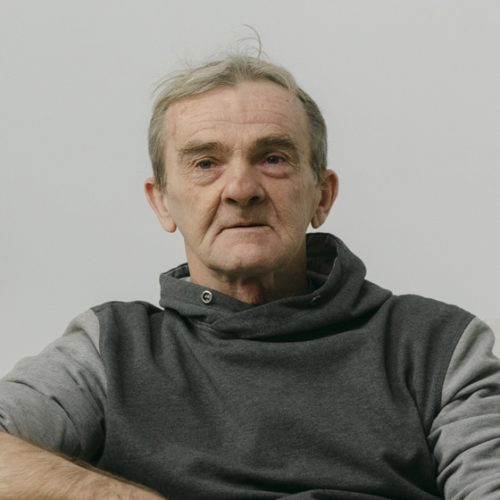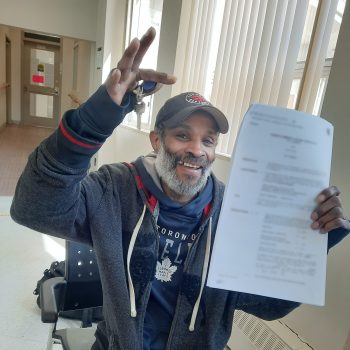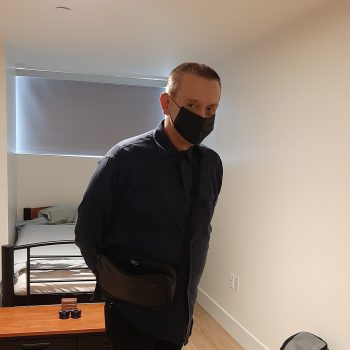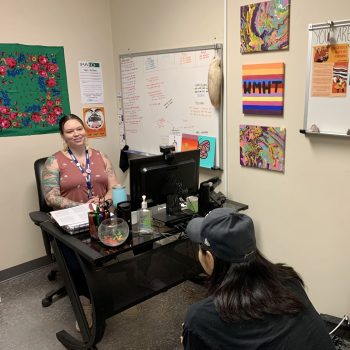
These are stories of people with lived experience of homelessness and their journeys toward permanent housing.

I left everything to flee for my safety.
In his home country, Bradshaw had a successful business and his family by his side. But his vocal criticism of a corrupt government made him a target. Facing increasing threats of abduction, torture and murder, he fled for his safety. “I left everything. What I came with was just a few clothes and a little money in my pocket.” Upon arriving in Toronto, Bradshaw went to 129 Peter St. – the City of Toronto’s Streets to Homes Assessment & Referral Centre. Describing the staff he met, Bradshaw says, “You could see that they care. They ask about your story, ask what’s going on – and tell you things will be okay.” In the shelter system, Bradshaw was supported with pathways to employment and housing.
Through his experience, Bradshaw saw the need among vulnerable individuals. With a strong desire to give back to the community, and a relevant academic and professional background, he began pursuing a career in social work.
Now working at Fred Victor, on the frontlines of the homelessness crisis, Bradshaw sees people from all walks of life in the situation he was once in himself. “I realized this can happen to anyone. And the shelters and housing programs are life-changing.”
Bradshaw continues, “Bad times don’t last. This is not the end of the world – you can still start from scratch and get back on your feet. Having hope is very important.”

My landlord sold the house I lived in.
James was already struggling to find a good job and afford rent. Then, his landlord sold the house he was living in just as the pandemic began. James was blindsided – left with no place to live and nowhere else to turn. Not long after, a City of Toronto street outreach team found James sleeping in the vestibule of an apartment building and asked if he wanted to go to a shelter. Although nervous, he said yes. He says, “It was one of the greatest things to happen to me.”
For James, the transformative aspect of the shelter is having a community of support around him. “I have the most wonderful people surrounding me – my fellow residents and the staff. Nothing in my life could have been possible without them.”
It was there that James was connected to his job as a peer support worker. In a supportive role at a hospital, James works with individuals experiencing homelessness who are accessing the healthcare system. He says, “I try to offer compassion.”
James explains, “I live with people who have come from good homes, have had good jobs, have had successes in their lives, but they’ve suffered some sort of unforeseen setback and they’re trying to deal with it as best they can.”
He continues, “Homelessness can happen to anybody. If it was you or your family member, you would want them to be looked after – the way I was.”
Looking ahead, James dreams of having a place of his own. “My number one hope is to have some form of permanent housing within a community. It would be close enough to my job and to get together with people. Then, I could have some peace of mind.”

I had a good job. I had everything I needed.
Jonathan lost a lot when his father passed away. He says, “I relied on him so much that when he died, I just let everything go. I basically had a nervous breakdown. I didn’t know how to deal with it, so I just walked out on life.” “I was out in the street for two to three years before I went to the shelter. A friend of mine dragged me there because he was scared I was gonna freeze to death.” Jonathan ended up at the Scott Mission – and began his journey out of homelessness.
Jonathan says, “They feed you. They clothe you. You have a bed. You have hot meals. And they’ll sit and talk to you and try to work out your problems. I’m so glad I went to that shelter because I really sense an improvement in my quality of life.”
Since leaving the shelter, Jonathan has been stably housed for seven years. He is a regular volunteer at the Fort York Food Bank – an organization that provides hot meals and groceries to low-income individuals and families in downtown Toronto.
“I had a spot for like four years where I was really unhappy. Now, I see people coming into the food bank and I see them leave smiling. How can you feel bad about that? I’m very grateful that I woke up today because it gives me a chance to have a better day than the day before.”

I slept in my car that first night.
“Things had changed in my life. My condo costs were sky-high and I decided to sell. I put everything in storage and kept some personal things with me,” says Lynn, describing how she went to live with her sister in a one-bedroom apartment. “After a few days, my nephew noticed that I was sleeping on the couch. He said it was my sister’s apartment and that I should be paying rent. Then, he kicked me out.” For the next seven weeks, Lynn lived in her car.
The situation would take a drastic toll on her physical health. “I had an appointment with my doctor who saw my swollen legs – I couldn’t fully recline in my car to sleep – and my doctor said to me, “Lynn, what’s going on?” And I told her, “I have nowhere to go.”
Lynn’s doctor made a call and got her into a City of Toronto shelter. Although initially feeling “out of place”, Lynn always kept a smile on her face. Soon, she says, “Everyone called me “mom”. So, I helped them when they’d ask for help.”
In return, Lynn was helped by the shelter staff. She says, “I felt wonderful. I felt supported. I felt they had my back and knew my situations.” And ultimately, they were able to assist Lynn in securing housing for seniors.
Now, despite some health issues, having a home keeps Lynn focused on the positive. “I’m upbeat. I’m taking one day at a time and being happy. I will never stop being the person that I am, because it makes other people feel so good.”

Karl was released from jail days before…
After being released from jail, Karl found himself in an encampment under the Gardiner Expressway. That’s where he met Sarah and Russell – two Street Outreach Counsellors. His decision to speak with them changed his life.
Although hesitant at first, Karl ended up having a long talk with the counsellors. He told them about his substance use, his struggle to find work, and how he lost his ID and most of his belongings. Sarah and Russell helped Karl enter the shelter system.
Working with Sarah, Karl got all the necessary documentation to qualify for a home through the City’s Rapid Rehousing Initiative. A few weeks later, he secured a bachelor apartment in the community he grew up in. It was what he always wanted.
Karl got emotional when he signed his lease – grateful for the support he received. He commends the counsellors for listening to him and helping him find a place to call home. By opening up to Sarah and Russell, Karl opened the door to safe, stable housing.

Living in a tent weighed heavily on my emotional and mental health.
Becoming homeless and having to live in a tent in Allan Gardens weighed heavily on Michael’s emotional and mental health. He was feeling anxious and stressed a lot.
“When I met Gareth – a City of Toronto street outreach worker – he told me that his job was to find me housing that is suitable to my needs. Then, he told me that Homes First (a City-funded agency) had a really nice unit to show me. I am so grateful to Gareth, Streets to Homes, and Homes First for all of the work that they have done to get me this apartment. I’m in a really nice bachelor apartment that I now call home.”

G.E. became homeless during the pandemic.
After losing his job and his housing on the same day, G.E. made his way to Seaton House for shelter. That’s where he connected with Laura – an Indigenous counsellor.
The purpose of the Indigenous counsellor and the Indigenous Case Management Support Program is to promote and provide culturally relevant services to the Indigenous residents at Seaton House. Working with Laura and Indigenous-led partner agencies like Anishnawbe Health Toronto and the Native Canadian Centre of Toronto, G.E. was able to access supports and services, and ultimately, secured permanent housing.